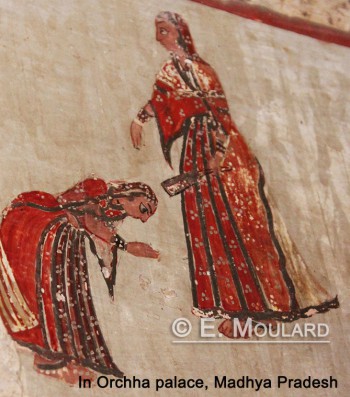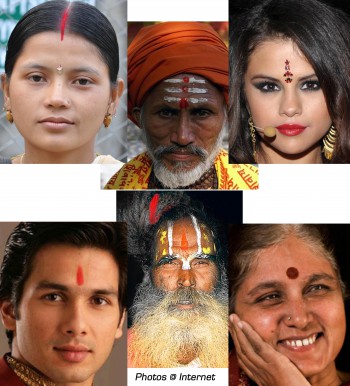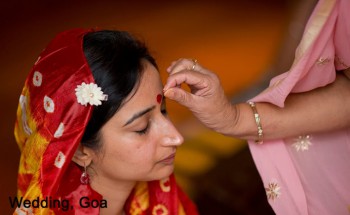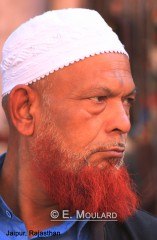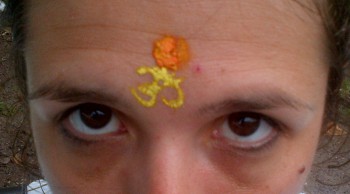10/18/2013
Why in India they touch the feet of their elders?
Be careful where you put your feet in India!
For instance, when you are sitting, you must not point your feet towards others, especially if they are old.
Or, one of the worst insults you can do to a Hindu is to throw a shoe in his face (I just found that out and find it good to know!). Walking on a guy while trying to climb onto a train berth also works quite also... (this I have tested for you! At the same time I am not sure any of my compatriots would like it too much either!)
In fact, when a Hindu touches your foot or shoe by accident, he makes a weird gesture (reaching out to your foot and then to his heart or his chin): his way to apologize. A question of education. Like when some people apologize after sneezing...
Morality: guys, avoid playing footsie under the table with a girl to hit on her!
You must remove your shoes at the temple (always) and in houses (in general). It’s quite an easy operation because many Indians wear open shoes, which also reduces foot odors...
And what about foot mycosis? I remember how I laughed when a French friend got shit scared of catching some because he was forced to walk in the puddles in flip-flops (monsoon obliges). I had never thought of it! What makes me laugh even more is discovering, by doing some research, right now, I learn that the foot fungus and other dermatophytes, are a major health problem in tropical countries like India, with sometimes risks of epidemic. When I think about the floor of that temple filled of rat piss and rain water! At the same time it is not so much of a surprise when you think about all the stray dogs with scabies. Or about all these people delousing each other on the sidewalks. But no need to panic: I never caught any mycosis in seven years!
If you want to shock an Indian you can put your feet on a book, a journal, a computer, a piece of paper. It is just like if you stamped on the goddess of knowledge, Saraswati, who is embodied in all these objects. You may be wondering how one ends up with his feet on a book but when you study very late every night, you often end up instinctively with your feet on your desk as it eases blood circulation.
Similarly apparently Hindus should not blow on fire. Yeah it would be like blowing on the face of the God of fire, Agni. Not very polite is it?? That said I have seen many people blowing birthday candles!
The feet symbolism dates back to the Vedic time (the Vedas being texts of the fifteenth century BC) where the universe was the body of the God: there was a top and a bottom. The pure and the impure. Feet are at the bottom and therefore unclean, impure.
Any rule has an exception. Obviously. When it comes to feet, the exception is the feet of the gods, the spiritual leaders and the elders which are not dirty. So it's not gross to touch them; it is even a sign of respect. It is a gesture made on many occasions: a departure or return from traveling, a wedding, a festival, a religious ceremony etc. In the old times children had to touch the feet of their parents when going to bed and getting up.
My ex-favorite Indian had explained to me that in the Kerala tradition the eldest brother of the bride had to wash the feet of the groom, as a sign of respect.
When you bend to touch the feet of an elderly person he usually doesn’t let you finish your gesture and replies by touching your forehead and blessing you with wishes of long life, prosperity and wealth.
This custom seems to be very very old since it is mentioned in the Mahabharata (an epic that is not dated but probably more than two thousand years old) where it is written “touching the feet of the mother, father, teachers and elders with devotion and serving them until they are content and give their blessing, is what makes a person great and strong”.
It does not really explain the origin of the gesture. But I found an explanation I quite like. When you do yoga you are taught some notions of energy circulation. It is thus thought that by touching the feet of others we absorb their energy and in turn by placing their hand on our forehead they allow the energy to move from the hand to the head.
Sources : http://scholarsresearchlibrary.com/ABR-vol2-iss3/ABR-2011-2-3-88-93.pdf;
http://www.iloveindia.com/indian-traditions/touching-feet.html; http://www.window2india.com/cms/admin/article.jsp?aid=5991; http://www.volunteeringinindia.org/etiquette-and-customs.htm; http://www.sanskrit.org/www/Hindu%20Primer/feetsymbolism.html
08:00 Posted in Why in India... | Permalink | Comments (0) | Tags: india, feet, touching feet, customs, fungal infection, dermatophyte, traditions, energy, mycosis, respect | ![]() Facebook | |
Facebook | |
10/14/2013
Why in India people have red marks on the forehead?
Or, if we dig deeper, Who, when, how, where?
We can distinguish different ‘marks’: the dot in the middle forehead, the line at the root of the hair and the lines and other designs on the forehead. These marks are often red, but not always. It’s not easy to understand the whole thing!
So who wears what? Does a red dot mean a woman is married?
In North India, the red dot on the forehead would be traditionally the prerogative of married women. But not in South India. Anyway it has become a fashion element, which varies in shape, color and material (the sticker – top right photo – has been giving tough competition to the traditional bindi – bottom right).
It seems however that the sindoor applied at the root of the hair (top left) is only applied by married women (a way of saying don’t touch! – like others do with a ring!).
Men can also wear the tilak, for religious or aesthetic reasons.
In fact anyone (Hindu or not, man or woman, Indian or not) will bear a red mark on the forehead after attending a puja (religious ceremony): whether it's a small prayer at home or in the temple, it always ends by a marking on the forehead...
So... why?
Firstly for aesthetic reasons: Indians find it beautiful! Tastes and colors are not to be discussed...
Secondly the dot on the forehead is a Hindu religious symbol since the tilak, placed on the sixth chakra (‘agna’), represents the third eye or the eye of the mind, associated with deities and the concepts of meditation and spiritual enlightenment. It was originally exclusively for ‘knowledge holders’: idols, priests, ascetics. (1) The Vishnu worshippers’ tilak is a U of white color (obtained from sandalwood) drawn around a red or black line (bottom middle photo). And for Shivaites it is formed by three horizontal lines made from ashes (top middle). (2)
But above all there is a 'scientific' explanation: the body– the forehead and the point 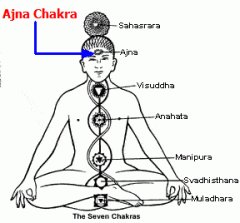 between the two eyes (seat of memory and thoughts) in particular – would produce energy in the form of electromagnetic waves. That’s how stress or anxiety creates heat and causes headaches. (1)
between the two eyes (seat of memory and thoughts) in particular – would produce energy in the form of electromagnetic waves. That’s how stress or anxiety creates heat and causes headaches. (1)
In Tantrism, during meditation, energy flows from the base to the head and leave the body by this point; hence the idea of "plugging the hole" to retain the energy inside. (3)
It is therefore to protect themselves and avoid energy losses that Hindus mark their forehead with a soothing and cooling powder paste.
Indeed, if the 'mark' varies in shape, colour, material and name ('tika', 'pottu', 'sindoor', 'tilak', 'tilakam', 'kumkum' and 'bindi', 'vermilion'), the traditional base (kumkum powder) is obtained by adding a few drop of lime to the yellow turmeric powder which then turns red (and add a little water to make it a paste). Some recipes contain saffron. And it turns out that both turmeric and saffron have medicinal properties as pain-killers! (4)
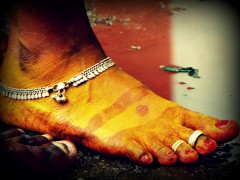 Turmeric is very present in the Indian culture. For example, in Andhra Pradesh, women used to apply it on (and under) the feet every day to protect them (because there were not too many shoes at the time (not that everyone wears shoes today either)). (5)
Turmeric is very present in the Indian culture. For example, in Andhra Pradesh, women used to apply it on (and under) the feet every day to protect them (because there were not too many shoes at the time (not that everyone wears shoes today either)). (5)
Indians may not have invented hot water* (not that they really need it anyways!) but their knowledge about medicinal plants is simply fascinating! Take henna. Not only is it cooling,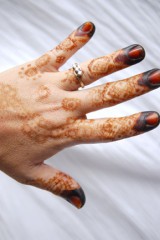 but also it is a coagulant for open wounds. Hence the tradition of Indian women to apply henna on their fingertips to protect themselves from the injuries inherent to manual chores. (6)
but also it is a coagulant for open wounds. Hence the tradition of Indian women to apply henna on their fingertips to protect themselves from the injuries inherent to manual chores. (6)
Here I owe an apology to my mother... After asking a thousand questions she came up with this one: “Tell me, why do these men have orange hair and beard?” I was a little bit upset with myself for not knowing the answer so I just told her whatever non-sense came to my mind: it is because they have used a bad quality dye which has faded!
In fact it seems that some men voluntary decide to have orange hair by dying it with henna. Apparently it could be because some Indians want to hide their gray hair but don’t have enough money to buy a good quality (black) dye. (7) The use of henna can also be linked to religion, as Islam would prohibit any dye except for henna. (8) When I asked my salesguy why do some people have orange hair he just told me that when people start to have gray hair they dye it, sometimes in black, sometimes in orange. No need to overthink it! You see Mum… ;)
* Sheer provocation?? Not only ! Apart from the zero, difficult to think of anything Indians actually invented… It doesn’t mean they are dumb though… They have stuff like the jugaad (in very short, “the gutsy art of overcoming harsh constraints by improvising an effective solution using limited resources”). Read more here.
(2) http://fr.wikipedia.org/wiki/Tilak
(3) http://hinduism.about.com/od/bindis/a/bindi.htm
(4) http://www.safrandugatinais.fr/en/vertus.htm; http://www.healthdiaries.com/eatthis/20-health-benefits-of-turmeric.html
(5) http://www.nandyala.org/mahanandi/?p=925
(6) http://www.ft.com/cms/s/0/d2933fb0-83de-11dc-a0a6-0000779fd2ac.html#ixzz2fW2qoFNh
(7) http://www.earthhenna.com/c158/c105/c98/The-Henna-Plant-c104.html
(8) http://ask.metafilter.com/88073/Why-would-a-Muslim-man-use-henna-to-dye-his-beard-orange
08:00 Posted in Why in India... | Permalink | Comments (0) | Tags: hair, hairs, beard, jugaad, innovation, orange, dye, henna, turmeric, saffron, spices, red dot, red mark, forehead, chakra, energy, meditation, third eye, tika, pottu, sindoor, tilak, tilakam, kumkum, bindi, agna, puja, kumkum powder, vermilion, orange hair | ![]() Facebook | |
Facebook | |















